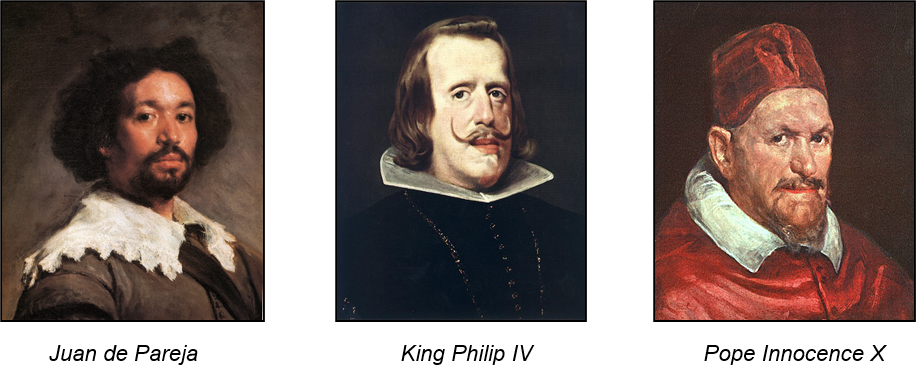


DIEGO VELASQUEZ 1599 -
Acknowledgements
Velasquez: Self-
Including:
Bartolomé
Murillo

xxxxxMainly because of Spain's decline from greatness -
xxxxxIncidentally, the stunning portrait of his servant Juan de Pareja (illustrated above), simply painted as a practice piece before he began his portrait of Pope Innocence X, became a masterpiece in its own right. At auction in 1970 it stunned the art world when it raised £2,310,000! Prior to this no painting had even reached the million mark!
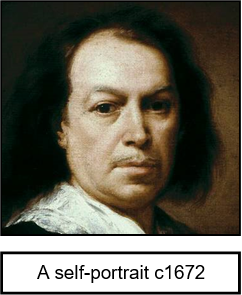 xxxxxAs mentioned above, a fellow artist and countryman at this time was Bartolomé Murillo (1617-
xxxxxAs mentioned above, a fellow artist and countryman at this time was Bartolomé Murillo (1617-
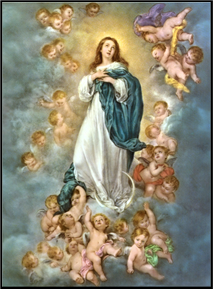
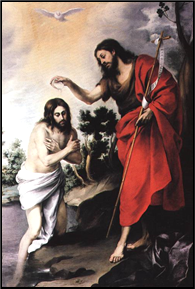 xxxxxHis eleven scenes from the lives of various saints, completed in 1646 for the small cloister of San Francisco in Seville, greatly enhanced his reputation and brought him a vast number of commissions, many from outside the city. It is said that during his career he painted 30 versions of the Immaculate Conception and of the virgin and child. Some of his work was produced as devotional images for the New World, and these included a mural for the cathedral in Guadalajara in western Mexico. He was the first president of the Seville Academy, founded in 1660, and, with the help of several assistants, produced a large number of works for the city's monasteries and churches. Notable among these were his Vision of St. Anthony for the cathedral, and a series of canvases for the Hospicio de los Venerables Sacerdotes, including the celebrated Immaculate Conception, a work of infinite tenderness painted in his "vaporose" (misty) style (illustrated left). His Baptism of Christ is illustrated on the right.
xxxxxHis eleven scenes from the lives of various saints, completed in 1646 for the small cloister of San Francisco in Seville, greatly enhanced his reputation and brought him a vast number of commissions, many from outside the city. It is said that during his career he painted 30 versions of the Immaculate Conception and of the virgin and child. Some of his work was produced as devotional images for the New World, and these included a mural for the cathedral in Guadalajara in western Mexico. He was the first president of the Seville Academy, founded in 1660, and, with the help of several assistants, produced a large number of works for the city's monasteries and churches. Notable among these were his Vision of St. Anthony for the cathedral, and a series of canvases for the Hospicio de los Venerables Sacerdotes, including the celebrated Immaculate Conception, a work of infinite tenderness painted in his "vaporose" (misty) style (illustrated left). His Baptism of Christ is illustrated on the right.
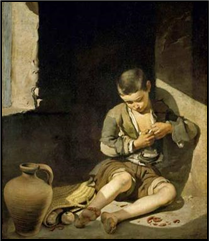
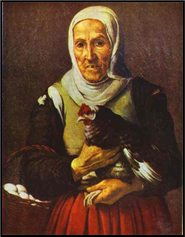 xxxxxApart from his religious themes, he was a fine genre painter. Indeed, today he is best remembered for his sympathetic depiction of street urchins, such as The Melon Eaters, Two Peasant Boys and his Young Beggar (illustrated left), the last named completed in 1655 and now in the Louvre, Paris. Illustrated on the right is his Old Woman with a Hen. These works are rightly admired for their human warmth and the realistic rendering of the still-
xxxxxApart from his religious themes, he was a fine genre painter. Indeed, today he is best remembered for his sympathetic depiction of street urchins, such as The Melon Eaters, Two Peasant Boys and his Young Beggar (illustrated left), the last named completed in 1655 and now in the Louvre, Paris. Illustrated on the right is his Old Woman with a Hen. These works are rightly admired for their human warmth and the realistic rendering of the still-
xxxxxMurillo died in 1682 following an accident. He fell from the scaffolding while working on the Mystic Marriage of Saint Catherine in the Capuchin church at Cadiz. His Self-
xxxxxThe Spanish artist Bartolomé Murillo (1617-
xxxxxThe Spanish painter Velasquez, court painter to Philip IV, was noted for his subtle colours and brilliant brushwork. He produced religious and genre paintings, but he excelled as a portrait artist, showing a remarkable ability to capture the character of his sitter, be he a monarch, aristocrat or commoner. Among his outstanding portraits are those of his servant Juan de Pareja, Pope Innocent X, and The Maids of Honour. Portraits apart, he is especially remembered today for his brilliant historical scene The Surrender of Breda, completed in 1635, and his captivating nude, the Rokeby Venus. Particularly notable among his religious works are The Immaculate Conception (in the National Gallery, London) and his Christ on the Cross. He became a close friend of Rubens, who visited Madrid in 1628, and he later met Nicholas Poussin and Giovanni Bernini. His style was influenced in part by Caravaggio and Titian, and his own work inspired Murillo and, later, artists such as Goya, Manet and Hopper.
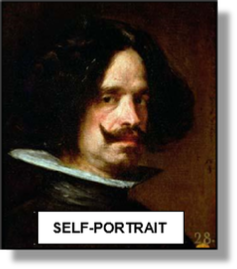 xxxxxThe Spanish painter Velasquez, long-
xxxxxThe Spanish painter Velasquez, long-
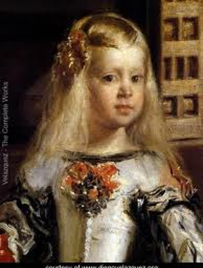
xxxxxUnlike many other artists, he worked slowly. This fact, combined with his preoccupation with court appointments, meant that his output was remarkably small for a career spanning some forty years -
xxxxxBut equally outstanding are two works outside his normal themes, one portraying a moment in history, the other a reclining nude. The Surrender of Breda, completed in 1635 and commemorating the Spanish capture of the Dutch town ten years earlier, ranks as one of the most successful paintings depicting a contemporary historical event. The gesture of clemency shown by Ambrogio Spinola, the Spanish commander, as he receives the key to the city is brilliantly depicted (detail illustrated below), as are the mixed emotions of the scene itself. It was painted as one of a series of works depicting the military successes achieved during Philip IV's reign -
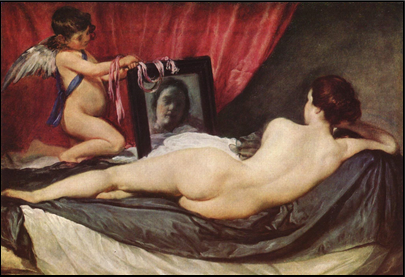 xxxxxIt is known that Velasquez painted a number of female nudes, but the lovely Rokeby Venus (illustrated) is the only one which has survived. More's the pity. Clearly inspired by the Venetian artist Titian, this work of natural beauty was painted for a Spanish nobleman, but later came into the possession of the Morritt family from Rokeby in Yorkshire, hence its name. It can now be seen in the National Gallery, London. In 1914 a suffragette visited the Gallery and badly damaged the Rokeby Venus, slashing it with a knife. It was expertly repaired, but if one examines the painting carefully the marks of the attack can still be seen.
xxxxxIt is known that Velasquez painted a number of female nudes, but the lovely Rokeby Venus (illustrated) is the only one which has survived. More's the pity. Clearly inspired by the Venetian artist Titian, this work of natural beauty was painted for a Spanish nobleman, but later came into the possession of the Morritt family from Rokeby in Yorkshire, hence its name. It can now be seen in the National Gallery, London. In 1914 a suffragette visited the Gallery and badly damaged the Rokeby Venus, slashing it with a knife. It was expertly repaired, but if one examines the painting carefully the marks of the attack can still be seen.
xxxxxVelasquez was born in Seville, and showed artistic promise at an early age. He was apprenticed to Francisco Pacheco, a local artist, and, via him, became acquainted with a cultured circle of painters and scholars. In 1619 he painted his Adoration of the Magi, but in this early period he tended to concentrate on "bodegones" (or "kitchen pictures"), depicting peasant life in accurate detail -
xxxxxIn 1628 Rubens visited Madrid on a diplomatic mission, and the two artists struck up a close friendship, assisted no doubt by their mutual admiration for Titian, whose works they studied at the Escorial. It was probably Rubens who encouraged him to travel to Italy the following year. He studied the great masters in Venice, and then visited Rome, ending his tour at Naples. Most of the work he carried out in Italy was subsequently lost, but the influence of classical art and the skill of the Renaissance masters are to be seen in the two canvases which have survived -
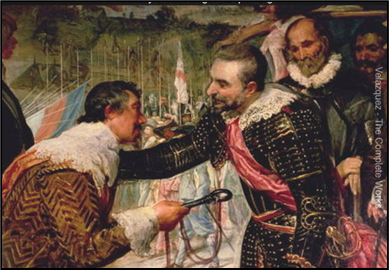 xxxxxVelasquez paid a further visit to Rome in 1649, during which he painted the celebrated portrait of Pope Innocent X and the Rokeby Venus. On this occasion he met the French artist Nicholas Poussin, who spent much time in Italy, and the famed Italian sculptor and architect Giovanni Bernini. But this visit apart, on returning to Madrid in 1631 he spent the rest of his life -
xxxxxVelasquez paid a further visit to Rome in 1649, during which he painted the celebrated portrait of Pope Innocent X and the Rokeby Venus. On this occasion he met the French artist Nicholas Poussin, who spent much time in Italy, and the famed Italian sculptor and architect Giovanni Bernini. But this visit apart, on returning to Madrid in 1631 he spent the rest of his life -
xxxxxVelasquez married Juana, the daughter of his tutor Francisco Pacheco, in 1618, and they had two daughters, one of whom died in infancy. His wife may well have been a model in his religious works The Adoration of the Magi and the Immaculate Conception, dated 1644. It would seem that whilst in Rome in 1650 he had an affair with a widow called Martha, and fathered an illegitimate son named Antonio. If such were the case, it in no way affected his standing on his return to Madrid. In November 1659, with the blessing of the pope, he was made a Knight of the Order of Santiago. The following year he made a diplomatic mission to the Franco-
C1-
